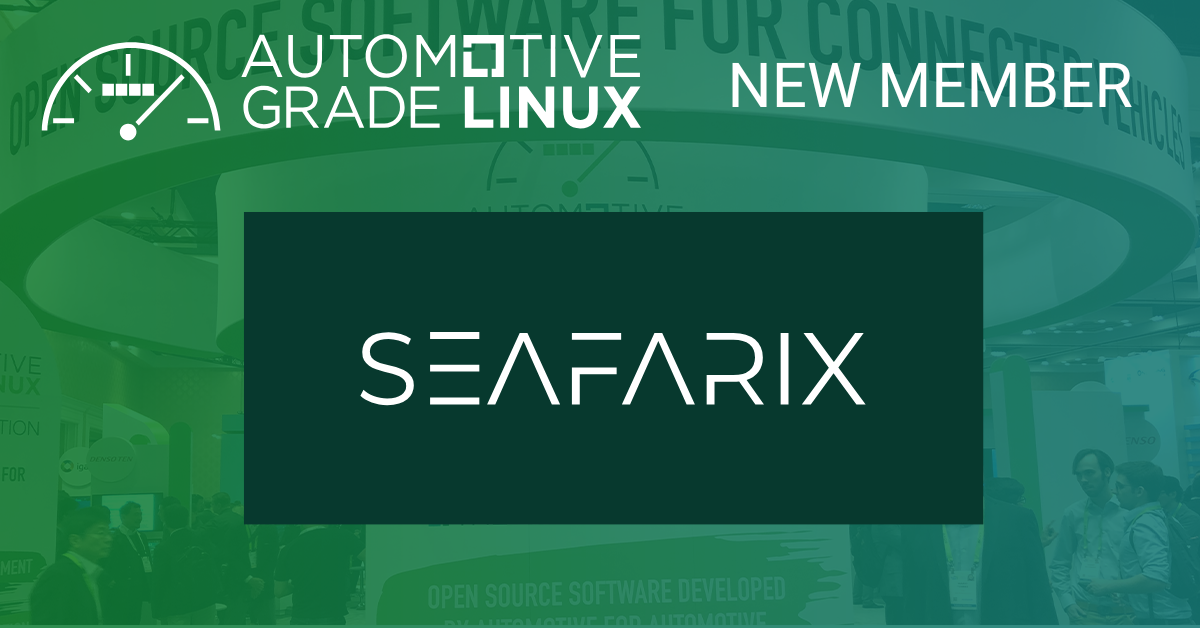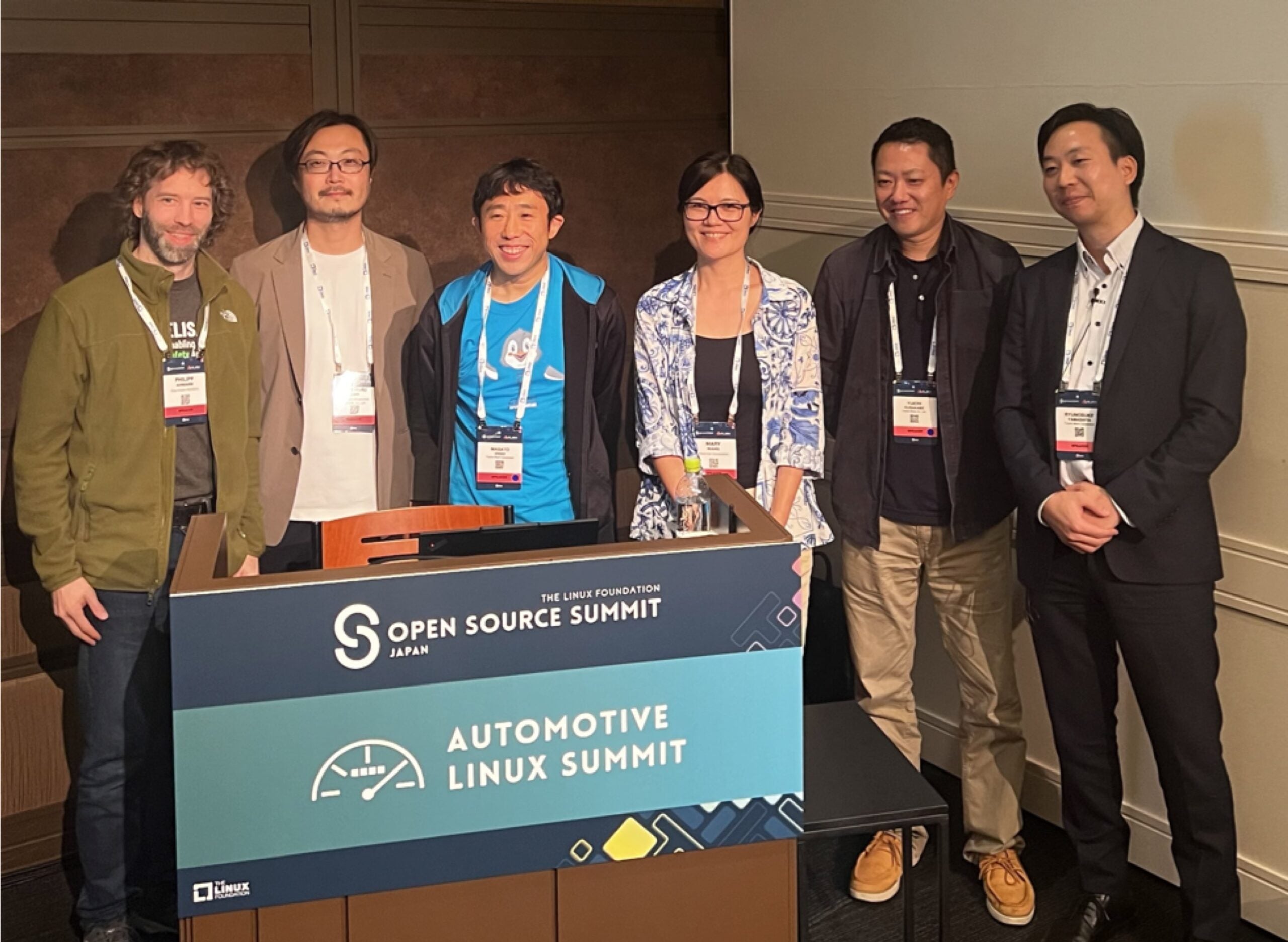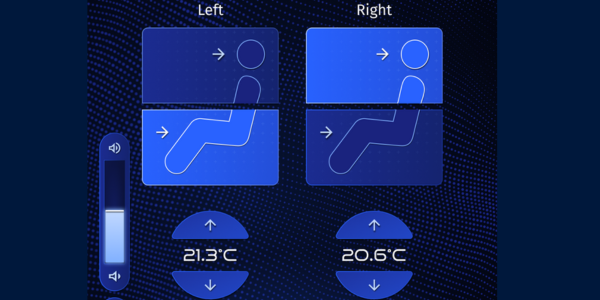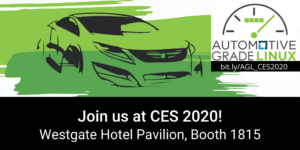
Automotive Grade Linux Booth at CES 2020 Showcases 2020 Mazda CX-30, 2020 Toyota RAV4, and 20+ Open Source AGL-Based Demos
18 AGL members including DENSO, DENSO TEN, Mazda, Panasonic, Renesas, NTT DATA MSE, and Suzuki, will show instrument cluster, infotainment, connected car, and cybersecurity applications running on AGL technology
SAN FRANCISCO, December 3, 2019 – Automotive Grade Linux (AGL), a cross-industry effort developing an open source platform for all connected car technologies, will be at CES 2020 demonstrating open source infotainment and instrument cluster applications along with 20+ connected car demonstrations developed by AGL members.
The AGL Booth in the Westgate Hotel Pavilion #1815 will feature a 2020 Toyota RAV4 with an AGL-based multimedia system that is currently in production, a 2020 Mazda CX-30 showcasing a proof of concept (POC) demo using new AGL reference hardware, and automotive technology demonstrations by: AISIN AW, DENSO, DENSO TEN, Igalia, IoT.bzh, LG Electronics, Mazda, Microchip, NTT DATA MSE, OpenSynergy, Panasonic, Renesas, SafeRide Technologies, Suzuki, SYSGO, Tuxera and VNC Automotive. The booth will be open to the public during CES show hours from January 7-10, 2020.
“Instrument Cluster has been a big focus over the past year, and we look forward to demonstrating the amazing work being done by our members to optimize the AGL platform for use in lower performance processors and low-cost vehicles, including motorcycles,” said Dan Cauchy, Executive Director of Automotive Grade Linux at the Linux Foundation. “We are proud to be showing vehicles from Toyota and Mazda and we will also have 20+ open source demos in our booth, a small sampling of some of the AGL-based products and services that automakers and suppliers continue to bring to market.”
AGL is an open source project hosted at the Linux Foundation that is changing the way automotive manufacturers build software. More than 150 members, including 11 automakers, are working together to develop a common platform that can serve as the de facto industry standard for infotainment, telematics, and instrument cluster applications. Sharing an open platform allows for code reuse and a more efficient development process as developers and suppliers can build once and have a product work for multiple automakers.
The AGL Unified Code Base (UCB) platform includes an operating system, middleware and application framework, and provides 70-80% of the starting point for a production project. Automakers and suppliers customize the other 20-30% of the platform with features, services and branding to meet their product and customer needs.
Many AGL members have already started integrating the UCB into their production plans. Mercedes-Benz Vans is using AGL as a foundation for a new onboard operating system for its commercial vehicles. Toyota’s AGL-based infotainment system is now in Toyota and Lexus vehicles globally and will be on display in the AGL booth in a 2020 Toyota RAV4. A list of additional products and services that support AGL are available are in the AGL Vendor Marketplace.
AGL DEMOS AT CES 2020
The AGL booth will feature several core UCB demos developed collaboratively by the AGL community, as well as 20 product and proof of concept (PoC) demos.
The AGL booth will be open to the public during CES show hours and during the AGL Evening Reception & Demo Showcase on Wednesday, January 8, from 6:00 – 8:00 pm PT. Additional details and registration for the Evening Reception are available here.
Media and analysts are also invited to attend an AGL Media Happy Hour at CES on Tuesday, January 7, from 3:00 – 5:00 pm PT in the AGL booth. RSVP here or contact us to schedule an on-site briefing.
Core AGL UCB Demos:
- Instrument Cluster: Infotainment and Instrument Cluster applications using container technology to run on a single microprocessor core. The speedometer and tachometer, along with a center display, show information from the infotainment system such as map data and media player information.
- Infotainment: demonstrates media player, tuner, navigation, web browser, Bluetooth, WiFi, HVAC control, and audio mixer applications running the latest Happy Halibut code release (8.0.4). Adjust the HVAC or control multimedia via voice recognition with Amazon Alexa.
- Steering wheel: A production steering wheel from Suzuki is incorporated into both demos. The second demo unit features the Infotainment and Instrument Cluster running on different boards with a CAN bus connection between them to share commands from the steering wheel as well as other vehicle data such as speed from a basic vehicle simulation. Commands available from the steering wheel include media functions and cruise control.
Demos by AGL members:
- Aisin AW – AGL Low-Spec Cockpit: Demonstration shows another container integration based on a new draft version of AGL platform architecture.
- DENSO and DENSO TEN – Next Gen Cockpit System: Next Gen Cockpit System demonstrated by DENSO and DENSO TEN.
- Igalia – HTML5 apps on AGL platform: Pure HTML based UI and applications running on the different AGL reference hardware boards.
- IoT.bzh – AGL@Sea: Ship cockpit simulation using the AGL platform with HTML5 and Android apps running inside secured containers with a cybersecurity attack scenario.
- LG Electronics – HTML5 UI/UX for Automotive Infotainment with Autonomous Driving Simulation: Flexible and user-customizable HTML5 UI/UX for automotive infotainment using LG’s Web App Manager and Enact framework running on AGL, along with the open source LGSVL Simulator which supports development and testing of autonomous driving software (e.g. Autoware, Apollo, or the AGL Unified Autonomous Driving Platform).
- Mazda – New Reference Hardware Demo on the 2020 Mazda CX-30: Showcasing interchangeable architecture hardware with 2 DIN form factor designed by the AGL Reference Hardware System Architecture Export Group. AGL demonstration running on the new reference hardware in 2020 Mazda CX-30.
- Microchip Technology – INICnet™ Technology – Microphone Network & eCall: Showcasing AGL in conjunction with a safety critical application. Based on INICnet™ technology, it features an emergency response system (eCall) with a Simplex Daisy chain topology and the network diagnosis feature.
- NTT DATA MSE – Voice Agent Service: Realization of a hybrid voice agent service based on AGL. User can receive various feedback from an agent service just by talking to it.
- OpenChain Project – Open Source Compliance for Automotive: The OpenChain Project will demonstrate how open source tooling can help automate open source compliance in the automotive industry. The demonstration will be based on real world experiences from companies in key automotive manufacturing markets such as Japan.
- OpenSynergy – Automotive Virtual Platform based on certified Hypervisor: Hypervisor-based cockpit solution enabling a virtual platform which integrates a large number of different functions, from entertainment and infotainment applications to Telematics Control Units (TCU) to Driver Information Systems. The solution integrates AGL and the hypervisor is the first Type 1 hypervisor compliant to ISO 26262:2018 ASIL-B.
- Panasonic – AGL VR Cockpit: Improved Development Kit: Advanced HMI Development tools for AGL using Reference Hardware and HMD (Head Mounted Display). The Reference Hardware enables engineers to start IVI software development without production hardware, reducing software development lead time. The HMD, produced by Panasonic, features a wide view angle which is effective for evaluating cockpit HMI.
- Renesas – Cloud-based Vehicle Service Delivery Platform and Cockpit ECU Reference Solution: Demonstrate container based secure microservice deployment that supports easy to develop solution to realize Time to Market. Cockpit ECU will kickstart your development with this all new reference solution from Renesas.
- SafeRide Technologies – vSentry™: Multi-layer cybersecurity software solution for connected and autonomous vehicles that combines deterministic and zero false-positive protection for software network and connectivity – including IDPS, Firewall and Access Control – with a Machine Learning and Deep Learning profiling and anomaly detection technology for future-proof security.
- Suzuki – AGL Instrument Cluster Demo: Highlights how the AGL platform can be optimized for Instrument Cluster applications and for use in lower performance processors and low-cost vehicles that do not require an entire infotainment software stack.
- SYSGO – Secure Automotive Gateway: Secure Automotive Gateway demo with significant automotive security features such as Fast and Secure Boot, an intrusion detection system (IDS), a simulated software over the air (OTA) process, firewall and a secure application loader. All of which is supported by a remote tablet, an infotainment screen and a cluster screen running on the latest AGL UCB release (Happy Halibut).
- Toyota – Multimedia: 2020 RAV4 with the latest infotainment system based on AGL.
- Tuxera – IVI/Cluster Storage Health Widget: A widget that Tier-1s, OEMs, or even end users can use to check the “health” of the flash memory storage. The demo will simultaneously demonstrate virtualization through a Xen hypervisor to run AGL and Android IVIs where the widget can be displayed.
- VNC Automotive – Connectivity that Moves: Demonstration of seamless connectivity between IVI and the mobile devices used within the car, and how a modular architecture can future-proof IVI systems by enabling them to be enhanced with additional applications and content provided by smartphones and add-on boxes. VNC Automotive will also have the first public unveiling of their new rear-seat entertainment solution. This uses the capabilities of AGL to aggregate multimedia content from multiple sources and stream them to the screens in the back of the car, as well as passengers’ tablets and headphones.
###
Media Inquiries
Emily Olin
pr@automotivelinux.org

